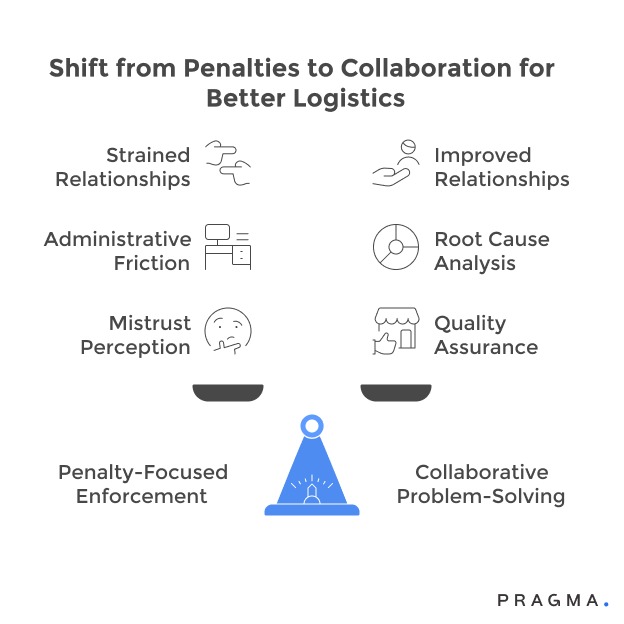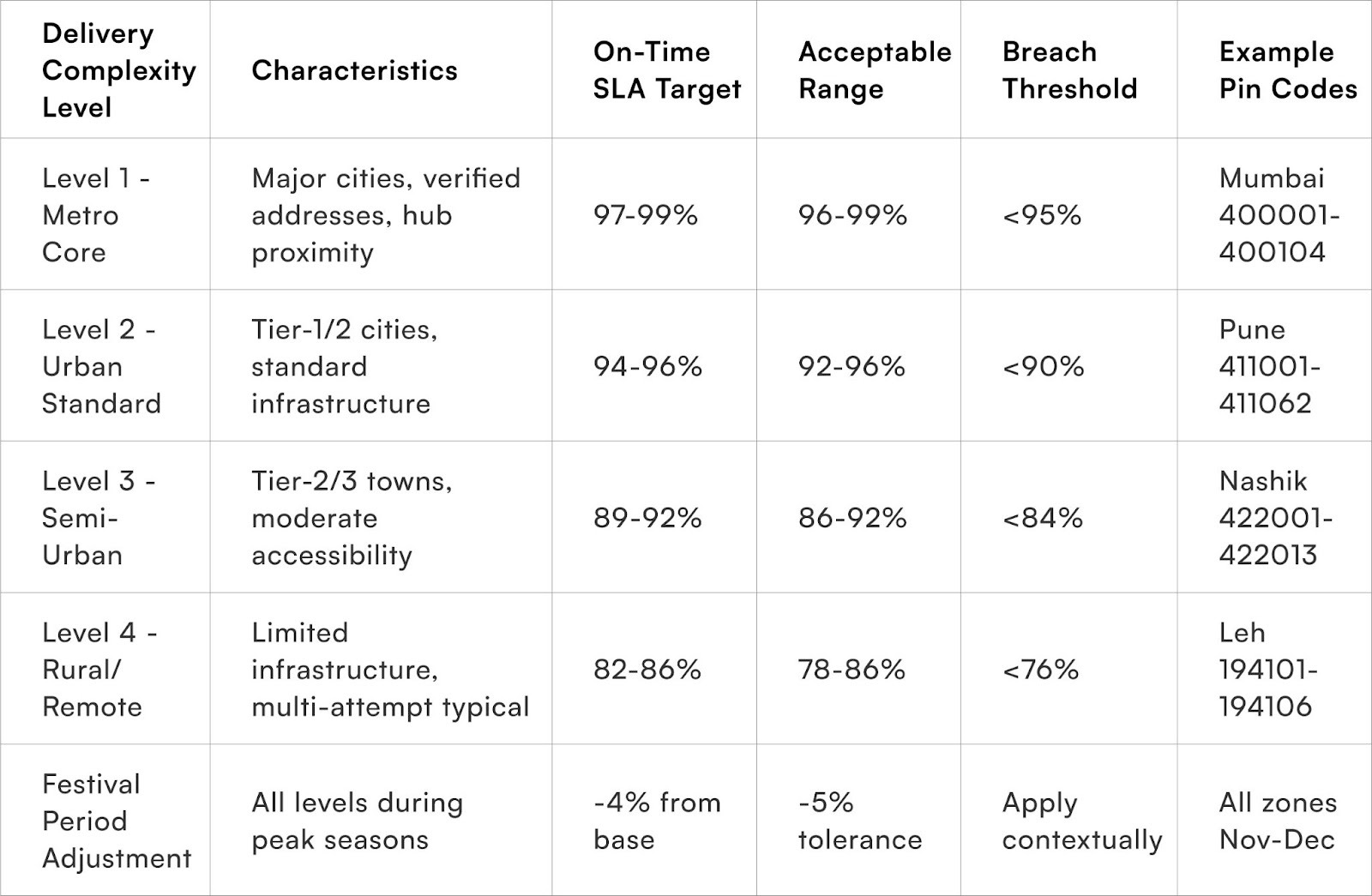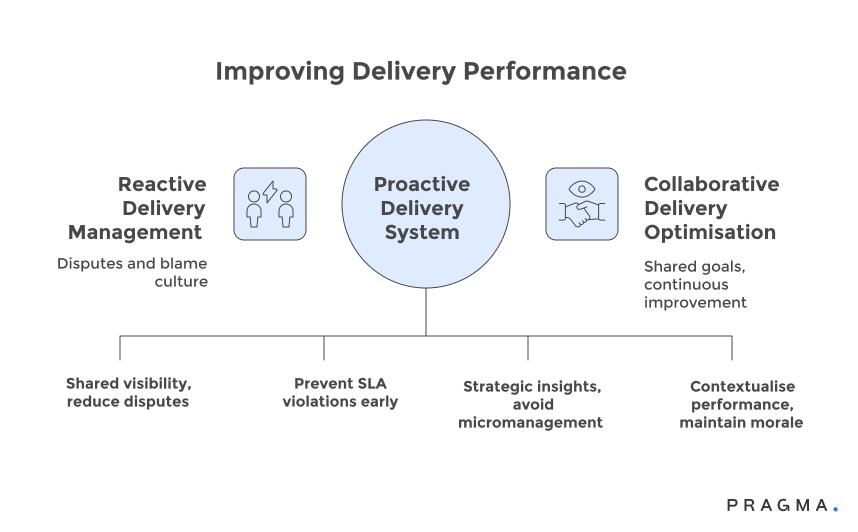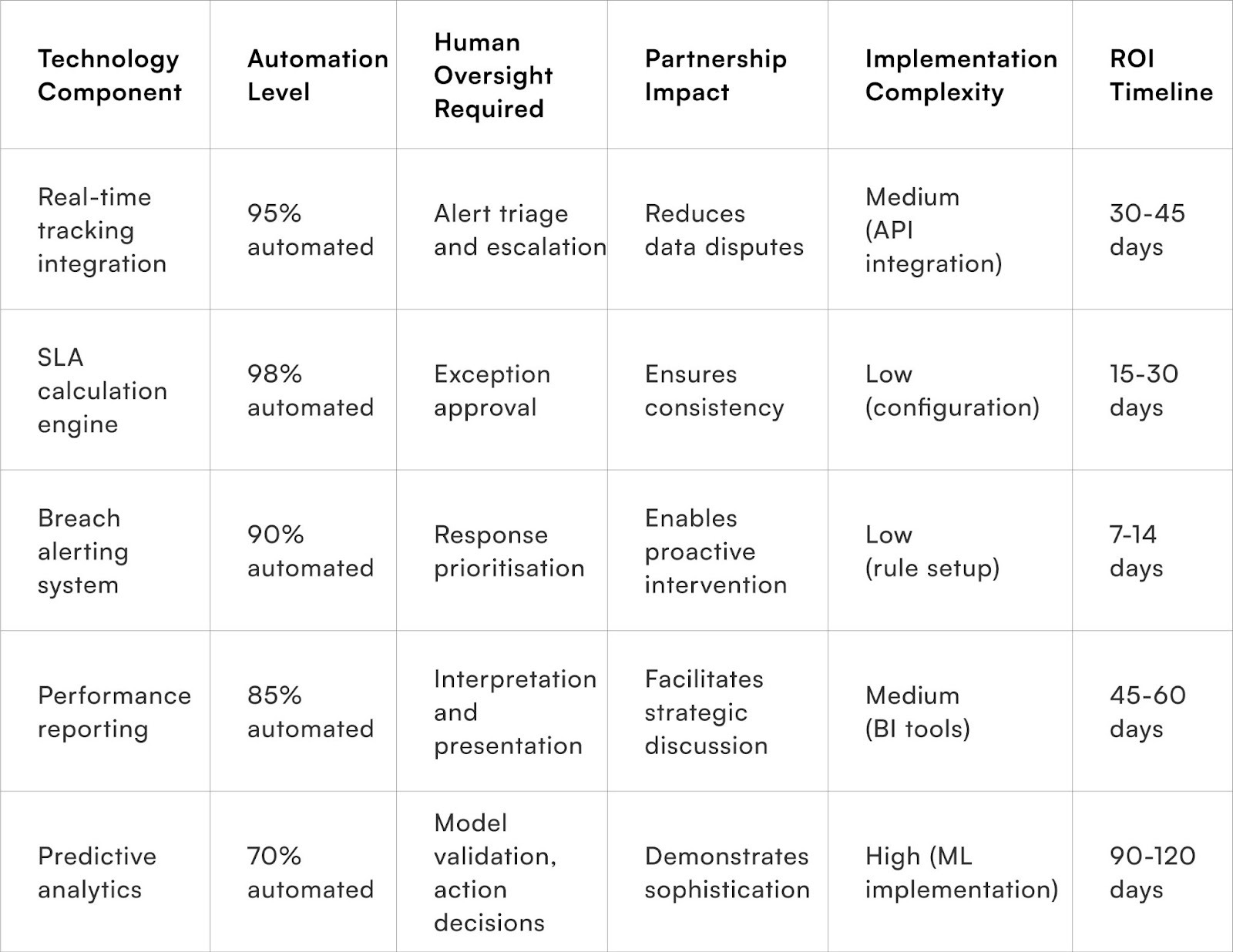Your courier partner misses delivery SLAs on 340 orders this month. You document each breach, compile evidence, and schedule a tense review meeting. The relationship grows adversarial. Next month, your difficult pin codes suddenly experience "capacity constraints" whilst your competitor's packages move smoothly. The enforcement worked, but the partnership didn't survive it.
Data from 73 Indian D2C brands managing multiple logistics partners reveals that aggressive SLA enforcement correlates with 23-31% degradation in service quality for "challenging" shipments within three months. Partners route difficult deliveries—remote pin codes, high-value COD, bulk orders during peaks—to brands they perceive as collaborative rather than punitive. Yet brands tracking but not enforcing SLAs see breach rates climb 18-26% annually as partners prioritise clients with consequences. The balance between accountability and relationship preservation determines operational sustainability.
In this comprehensive guide on SLA breaches in e-commerce and how to monitor and enforce without straining partners, we're exploring frameworks that maintain performance standards whilst building cooperative improvement relationships. Brands implementing balanced SLA management report 42-49% reduction in breach frequency, 67-73% improvement in partner responsiveness to issues, and 89% preservation of collaborative relationships over 18-month periods compared to 34% retention under purely punitive approaches.
Why do traditional SLA enforcement models damage partnerships?
Binary compliance measurement creates adversarial dynamics that incentivise defensive behaviour over improvement

Conventional SLA frameworks treat performance as pass-fail binary outcomes where 95% on-time delivery is contractually acceptable whilst 94.8% triggers penalty clauses. This threshold thinking ignores the operational reality that logistics performance exists on continuums influenced by factors beyond partner control. Weather disruptions, festival season volume surges, and customer availability variations affect all carriers differently based on network composition and resource allocation.
Penalty-focused enforcement particularly strains relationships when applied uniformly across heterogeneous shipment types. A breach delivering to a remote Himalayan village during monsoon season receives identical treatment to a metro area failure on a clear day. Partners perceive this undifferentiated accountability as unfair, leading to defensive behaviours including conservative capacity commitments, risk-averse routing decisions, and reluctance to accept challenging shipments that might damage their performance metrics.
Documentation-heavy breach processes create administrative friction that overshadows problem-solving collaboration. Brands collecting screenshots, tracking timestamps, and building evidence files for penalty justification spend operational energy on proving failures rather than understanding root causes. Partners facing meticulous breach documentation respond with equally meticulous contractual interpretation, transforming partnerships into legal relationships where both parties optimise for defensibility rather than customer outcomes.
The psychological impact of constant performance monitoring manifests in deteriorating relationship quality even when penalties aren't applied. Partners aware that every delivery attempt feeds surveillance systems experience the dynamic as mistrust rather than quality assurance. This perception shifts their approach from collaborative problem-solving to compliance theatre where visible metrics get prioritised over substantive improvements.
How can contextual SLA measurement improve accuracy and fairness?
Segmented performance expectations account for delivery complexity variations that uniform standards ignore
Intelligent SLA frameworks establish different performance thresholds for distinct shipment categories based on measurable difficulty factors. Metro area deliveries to verified addresses during normal seasons merit 96-98% on-time expectations, whilst Tier-3 towns during festival peaks might reasonably accept 85-89% targets. This segmentation acknowledges operational realities whilst maintaining high standards where circumstances permit.
Pin code complexity scoring creates objective basis for varied expectations. Factors including distance from courier hubs, average delivery attempts per successful completion, RTO rates, address quality patterns, and infrastructure reliability combine into difficulty ratings. Level-1 pin codes (easiest) receive strictest SLAs, Level-4 zones (most challenging) get realistic targets that neither excuse poor performance nor demand impossible consistency.
Seasonal adjustment mechanisms prevent unfair penalty accumulation during predictable high-stress periods. SLA thresholds automatically relax by 3-5% during Diwali, Christmas, and major sale events when entire logistics networks operate under strain. This flexibility demonstrates understanding of industry-wide challenges whilst maintaining year-round accountability during normal operating conditions. Partners appreciate the recognition that November performance inherently differs from March baselines.
Weather and external disruption protocols provide structured exceptions without creating loopholes. When IMD declares heavy rain warnings for specific regions, affected deliveries automatically receive extended SLA windows or bypass penalty calculations entirely. The key lies in applying these exceptions systematically based on objective external data rather than case-by-case partner requests that create negotiation friction.

What monitoring approaches balance visibility with trust?
Transparent measurement systems paired with forward-looking analytics shift focus from blame to improvement
Effective SLA management in e-commerce hinges on transparency and collaboration, moving beyond punitive measures to foster stronger partner relationships.

1. Shared Visibility through Real-time Dashboards:
- Eliminate Information Asymmetry: Real-time dashboards provide both brands and courier partners with identical views of delivery status, SLA countdowns, and breach alerts.
- Reduce Disputes: This shared visibility minimises factual disagreements and transforms monitoring into a collaborative effort, where both parties work from the same operational picture.
2. Proactive Intervention with Predictive Breach Warnings:
- Prevent Violations: Systems that detect shipments trending towards late delivery (e.g., packages still in transit 18 hours before a 24-hour SLA expires) alert both brand and partner teams.
- Shift to Collaboration: This early warning system reframes conversations from blame ("you missed SLA") to collaborative problem-solving ("how do we prevent this breach together").
3. Strategic Insights from Aggregate Trend Analysis:
- Meaningful Performance Insights: Monthly reviews of overall patterns, such as a 4% decline in on-time performance in a specific region, offer more valuable insights than individual breach counts.
- Avoid Micromanagement: This macro perspective facilitates strategic discussions about capacity, routing, or process improvements, preventing the micromanagement feel of item-by-item reviews while maintaining accountability for significant performance shifts.
4. Contextualising Performance with Peer Comparison Benchmarking:
- Reframing Conversations: Showing partners their 91% on-time delivery rate against an industry average of 87% for similar shipments provides valuable context that absolute numbers lack.
- Maintain Morale and Goodwill: Recognising relative outperformance, even when absolute targets are not met, is crucial for maintaining partner morale and goodwill, which are essential for continuous improvement.
How should breach penalties be structured to drive improvement?
Consequence frameworks emphasising correction over punishment maintain accountability whilst preserving relationships

1. Tiered Penalty Structures with Grace Periods:
- Progression: This system differentiates between isolated incidents and recurring issues.
- First Breach (within a quarter): Triggers a formal warning without financial penalty.
- Second Breach: Requires joint problem-solving initiatives.
- Third Breach (within 90 days): Activates financial consequences.
- Benefit: Allows partners to address and correct issues before penalties are applied, focusing on operational improvements rather than immediate financial burden.
2. Performance Improvement Credits:
- Alternative to Penalties: Instead of solely imposing financial penalties, offer opportunities for partners to earn credit restoration.
- Credit Restoration Methods:
- Documented process improvements.
- Additional tracking touchpoints for challenging shipments.
- Enhanced communication protocols.
- Benefit: Shifts focus from extracting payments to collaboratively fixing underlying operational issues, strengthening the partnership.
3. Sliding Scale Penalties:
- Proportionality: Calibrates penalties to the severity of the breach, ensuring consequences are proportionate to the impact.
- Example: A minor miss (e.g., 0.5% below a 95% target) might incur a small credit adjustment (e.g., ₹500), while a significant miss (e.g., 6% below target) could result in a larger penalty (e.g., ₹5,000).
- Benefit: Prevents disproportionate consequences for minor issues and ensures penalties are perceived as fair and justifiable.
4. Penalty Caps:
- Protection during Crises: Sets a maximum monthly penalty (e.g., 2-3% of shipment value) to shield partners from catastrophic financial exposure during uncontrollable events like natural disasters or pandemics.
- Benefit: Demonstrates a long-term commitment to the partnership by preventing single challenging months from destroying economic viability, while still maintaining accountability during normal operations.
Why does collaborative problem-solving outperform punitive enforcement?
Joint improvement initiatives address root causes that penalty application leaves unchanged
Root cause analysis conducted cooperatively reveals operational issues that blame-focused approaches miss entirely. When brands and partners jointly examine breach patterns, underlying factors emerge:
- insufficient local delivery staff in growing suburbs
- address format mismatches between systems
- peak-hour traffic patterns affecting specific routes
- or customer availability assumptions that don't match reality.
These insights enable targeted fixes rather than generalised pressure to "perform better."
Process improvement partnerships transform SLA management from compliance exercise into operational innovation opportunity. Brands might fund partner investments in route optimisation software, share customer contact preferences data that improves first-attempt success, or adjust order cutoff times that enable more reliable next-day delivery. These collaborative enhancements deliver lasting improvements that penalty-driven resentment never achieves.
Regular operational reviews create structured forums for continuous improvement dialogue. Monthly meetings examining performance data alongside upcoming operational challenges—festival season planning, new pin code launches, volume forecast adjustments—build partnership depth beyond transactional service delivery. These sessions position both parties as teammates solving shared challenges rather than adversaries in zero-sum performance negotiations.
Success recognition and partnership appreciation balance the inherent negativity of breach-focused conversations. Publicly acknowledging when partners achieve consecutive months of strong performance, overcome particularly difficult operational challenges, or implement innovative solutions maintains relationship positivity essential for long-term collaboration. Brands spending equal energy celebrating successes and addressing failures sustain partner engagement that purely problem-focused relationships cannot maintain.
What communication patterns strengthen accountability without creating friction?
Messaging cadence and tone choices determine whether performance discussions build or erode partnership trust
Issue escalation communication should follow graduated formality matching problem severity. Isolated breaches merit casual Slack or WhatsApp messages: "Hey, noticed a few delays in Bangalore South yesterday—anything unusual happening?" Recurring patterns warrant structured emails with data attachments. Systemic failures justify formal meetings with documentation. This graduated approach prevents overreaction to normal variation whilst demonstrating seriousness for genuine concerns.
Data-first communication removes emotional charge from difficult conversations. Leading with "delivery success rates dropped 6% in Zone 3 over two weeks" focuses discussion on observable facts rather than subjective performance judgments. Partners can engage with data objectively, identifying contributing factors without defensive reactions that accusatory language triggers. The neutral tone preserves collaborative problem-solving mindset even when addressing serious shortfalls.
Future-oriented framing emphasises solutions over blame attribution. Phrasing like "what adjustments can we make to improve next week's performance?" proves more productive than "why did you miss SLA targets?" The forward-looking approach acknowledges past issues whilst immediately redirecting energy toward corrective action. Partners respond more constructively when conversations position them as solution contributors rather than problem sources.
Frequency balance prevents both micromanagement perception and accountability absence. Daily operational calls during crisis periods demonstrate engaged partnership. Weekly check-ins during stable operations maintain connection without creating surveillance atmosphere. Monthly strategic reviews provide formal accountability structure. This varied cadence matches communication intensity to operational needs rather than applying uniform patterns that either overwhelm or underwhelm partnership requirements.
How can technology enable SLA management without replacing human judgment?
Automated monitoring systems handle measurement and alerting whilst preserving relationship-building conversations for humans
API integrations pulling real-time tracking data eliminate manual performance compilation that consumes operational hours whilst introducing data accuracy concerns. Automated systems calculate SLA compliance across thousands of shipments with complexity adjustments, seasonal factors, and exception handling that humans couldn't efficiently manage. This automation frees partnership managers to focus on interpretation, strategy, and relationship management rather than data collection mechanics.
Exception flagging algorithms identify genuinely concerning patterns whilst filtering normal statistical variation. Systems might alert when pin code performance drops 8% below historical averages but ignore 2% fluctuations within expected ranges. This intelligent filtering prevents alert fatigue that causes teams to ignore warnings whilst ensuring significant issues receive appropriate attention. The technology handles nuance that simple threshold alerts miss.
Automated reporting generates structured performance summaries that facilitate productive review conversations. Monthly reports showing performance trends, breach patterns by category, comparative peer benchmarks, and improvement trajectories provide shared factual foundation for partnership discussions. Both parties reference identical data sets rather than bringing competing interpretations to meetings, dramatically reducing negotiation friction over basic facts.

Predictive analytics identify emerging issues before they become systematic problems. Machine learning models detecting subtle degradation patterns—first-attempt success rates declining slowly across specific routes, delivery window estimates becoming less accurate—enable early intervention discussions. Partners appreciate brands raising concerns about trajectories rather than waiting for clear SLA breaches to trigger reactive conversations.
To Wrap It Up
SLA management functions as partnership health barometer rather than pure performance measurement tool. Frameworks emphasising collaborative improvement over punitive enforcement deliver superior long-term results through maintained relationship quality, voluntary partner investment in service enhancements, and sustained operational excellence that survives temporary challenges. The most successful brands view SLA breaches as operational intelligence revealing improvement opportunities rather than evidence for penalty application.
Audit your last 50 SLA breaches to identify the top three recurring patterns, then schedule collaborative working sessions with affected partners to co-create specific process improvements addressing each root cause.
Sustainable SLA management requires continuous framework refinement as partnerships mature, operational contexts evolve, and market dynamics shift. Brands investing equal energy in celebration protocols for consistent performance, process improvement partnerships addressing root causes, and technology automation handling measurement mechanics achieve 31-38% better long-term compliance than those relying primarily on penalty threats. The compound benefits of maintained partner goodwill, voluntary service innovations, and priority treatment during capacity constraints deliver operational advantages that purely transactional enforcement approaches cannot replicate.
For D2C brands seeking to optimise logistics partner performance whilst maintaining collaborative relationships, Pragma's partner performance management platform provides contextual SLA tracking, automated breach prediction, collaborative improvement workflows, and relationship health monitoring that help brands achieve 42-49% breach reduction alongside 67-73% improvement in partner responsiveness through balanced accountability frameworks.

FAQs (Frequently Asked Questions On SLA Breaches in E-commerce: How to Monitor and Enforce Without Straining Partners)
1. How can I monitor SLAs across multiple logistics partners without micromanaging?
Implement real-time dashboards that automatically track critical SLA metrics—like on-time delivery rate, first-attempt success, and response time—for every partner. Automated alerts flag early warning signs, letting you intervene only when necessary, instead of manual spreadsheet checks or daily calls.
2. What’s the most effective way to balance strict enforcement and long-term logistics relationships?
Use a tiered escalation model: start with transparent sharing of performance data and feedback, give partners a chance to self-correct, and only introduce penalties or rerouting when SLAs are repeatedly missed. Regular reviews and collaborative “root cause” sessions foster improvement, not resentment.
3. Which metrics signal an impending SLA problem?
Watch for rising exceptions: increased undelivered parcels (NDRs), slowing average delivery times, delayed first scans, or higher customer escalations. Trend changes in these metrics often precede systematic SLA breaches by days or weeks.
4. Can automation help reduce SLA breach frequency?
Absolutely—automation platforms aggregate event data, send instant breach warnings, and even suggest corrective actions based on past trends. Proactive monitoring and rules-based escalation prevent one-off issues from snowballing into full-blown violations, all while minimising day-to-day friction with partners
Talk to our experts for a customised solution that can maximise your sales funnel
Book a demo


.webp)
.jpg)
.png)